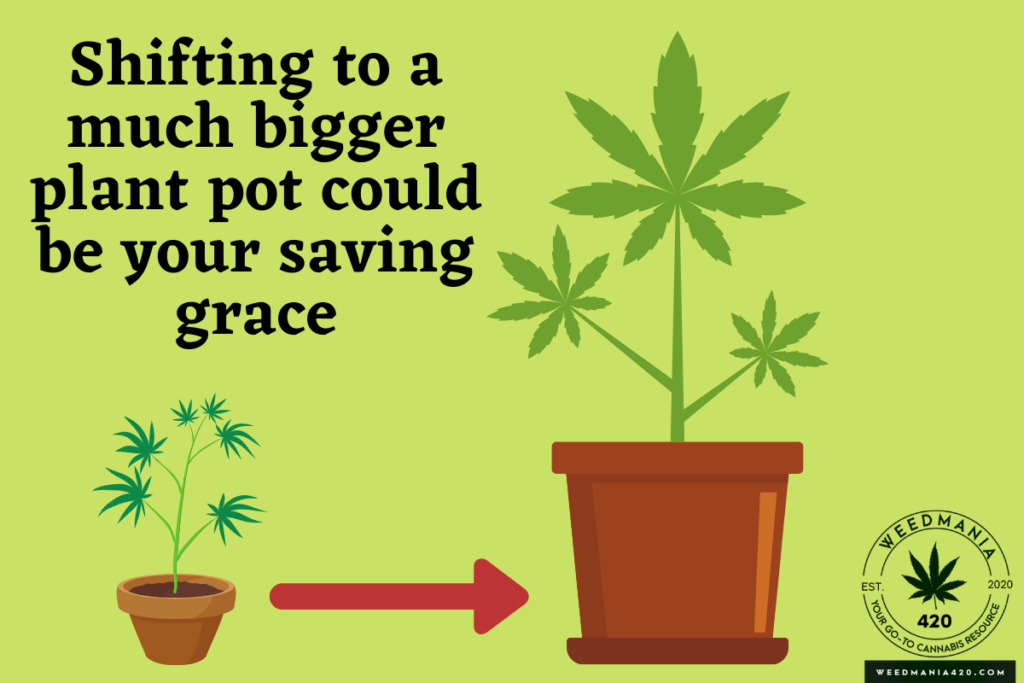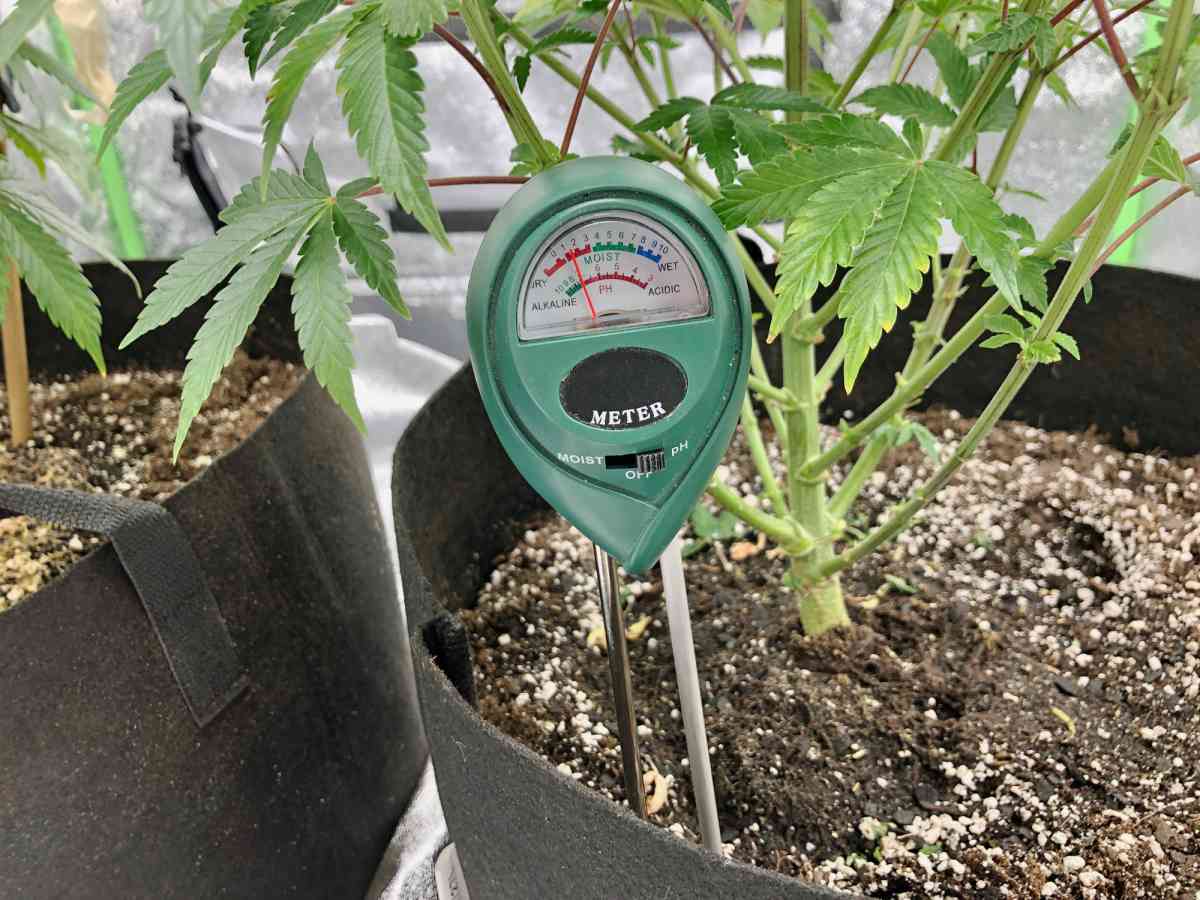Cannabis roots growing towards the top of soil is an indication that something isn’t right. A healthy root ball is vital for your plants through their growth and development.
The roots draw nutrients from the grow medium to other parts of the plant. Thus, tending to the roots rewards the overall plant’s health.
The roots also anchor your plant, and when they grow atop the soil, your plant’s stability is in jeopardy.
You might think stability doesn’t matter much when you grow in a pot indoors, but deeper roots that assure stability also guarantee nutrients and water for your plants.
Cannabis roots exposed to the air are unsightly. You want to have all the roots below the medium doing what they ought to do— sustaining the plant.
Table of Contents
What Causes Cannabis Roots Growing On Top Of Soil?
Cannabis roots growing above the soil is mainly caused by a lack of oxygen in the grow medium. The roots need to breathe, and so they reach for the air above the grow medium. Other than oxygen deprivation, the following factors can lead to roots growing above the soil.
Inadequate Pot Space
When the plant gets rootbound, it tries to find more space to grow, forcing the roots to grow upwards.
Indoors, your plants will get rootbound if you’ve used pots that are too small. If the plant is still in the vegetative stage, then repotting to a much larger pot solves your problems.
A bigger grow pot affords the roots more space, and thus, the roots can absorb all the oxygen they need.
The problem arises if you realize too late into flowering that the roots are growing on top of the soil because the grow pot is small. Repotting can stress your plant massively, but leaving it to flower in the small, limiting pot also reduces your yields.
Compacted Soil/ Poor Grow Medium
If your grow medium is too compact, the roots will find trouble accessing oxygen. A healthy root environment should make room for the roots to breathe.
Soil mediums can be compact, blocking all air from reaching the roots. You should consider adding vermiculite to break up the soil and allow the exchange of air between the environment and the roots.
The roots craving oxygen will grow upwards to take a breath of the much-needed oxygen.
Other mediums like coco coir too need to be well-aerated. Vermiculite
perlites, rocks, or anything that breaks up the compact medium will help your roots breathe below the medium.
Overwatering
When you overwater your plants, you leave no room in the pot for the oxygen to reach the roots.
Overwatering has loads of other troubles, but a combination of overwatering and compact medium is a surefire way to get the air-deprived roots atop the soil.
Too much water also cakes the medium. When you pour a lot of water on the medium, it leaves the surface even harder when it dries. This further inhibits airflow into the roots.
Make sure your drainage system works. You don’t want to keep the grow medium wet for too long. Waterlogging inhibits airflow and makes your roots more susceptible to rot.
When You Don’t Top Dress The Plant
Failure to top-dress your plant can also lead to the root getting exposed. Watering pushes the soil away from the plant’s roots, and the roots that are laid shallowly will get exposed.
This is far more physical because the plant doesn’t ‘fight’ to get on top; the grower simply neglects it.
Every time you water your plant, the soil is pressed down a little. Thus, you should top dress the plant to add more nutrients and a layer of covering.
You must replace the soil that’s swept away when you water to keep the roots farther from the surface.
If The Roots Run Into A Solid Obstruction
When indoors, you use grow pots and thus have no qualms worrying about the roots running into hard surfaces.
However, for outdoor marijuana plants, the roots can run into water pipes or rocks. These hard surfaces are impenetrable; thus, the roots will grow upwards.
Are Cannabis Roots Exposed To Light A Bad Thing?
Cannabis roots shouldn’t be exposed to the air because of air pruning. Air pruning happens naturally whenever the roots are exposed to air under low humidity. The air dries off the roots and kills them, forcing the plant to grow new roots constantly.
The constant growth of new roots doesn’t help the plant’s vertical growth because the plant spends most energy rebuilding the roots.
Besides, the roots don’t grow as deep as they should, affecting the plant’s nutrient supply. If the roots survive air pruning, they will harden like the stems and might even turn green. I could be wrong, but I don’t think roots with green backs still function as roots.
How To Fix Cannabis Roots Growing Above The Soil
The cannabis plant’s roots growing on top of the soil can hurt your progress. The roots don’t go as deep as they should in the soil, limiting the plant’s access to water and nutrients.
If you spot your cannabis roots growing above the ground, you should act fast. Here are ways to deal with the cannabis roots growing above the soil;
Transplant The Plant Into A Bigger Pot
Transplanting your plant into a much bigger grow pot creates more space for the roots. The roots will have a deeper and larger container for both vertical and sideways growth.
Be gentle with the plant when transplanting. A plant with roots growing above the soil has already endured stress. More stress arising from poor handling can be overwhelming for the plant.
Also, mind the stage of the plant. Transplanting is a better option if the plant is still in the vegging stage. If the plant is deep into flowering, transplanting isn’t the right idea.
The stress from transplanting can stall the plant’s progress, resulting in tiny buds. I wrote an in-depth article on how to transplant during flowering. In it, you’ll find this ‘stacking’ technique that will help you transplant with minimal stress.

Cover The Exposed Roots With Medium
Covering the protruding roots with another layer of grow medium will protect them from air pruning.
The roots also get to absorb nutrients from the grow medium swathing them, making them useful to the plant.
When covered, a crown will form at the base of the plant. The raised crown also helps to avoid depression at the base of the plant. The water will flow towards the edges of the container; thus the medium doesn’t get washed away.
Cover The Roots With Mulch
Air pruning only dries off roots when there’s less humidity. Covering the exposed with mulch inhibits moisture loss from the roots and protects the roots from the direct glare of lights.
This enables them to survive harsh environmental conditions. They’ll continue living and functioning for the benefit of the plant.
Another good thing with mulching is that it helps you reduce watering frequency because moisture loss from the medium is slower.
Mulching also makes it easier to find bugs that could spoil your plant. Flip the mulch in the morning and check beneath. If there are bugs in your grow, you’ll find them under the mulch.
Tip: Whatever you decide to do, ensure you aerate the grow medium. Protruding roots is the plant’s outcry for help. By aerating the medium, you’re attending to the entire plant— not just the affected roots!
What You Shouldn’t Do To The Exposed Roots
Exposed roots aren’t welcome, but how you handle them can either hurt your plant further or save them. Here are a few things you shouldn’t do;
Cutting the roots—When you cut the roots, you create new wounds that the plant will need to heal. The stress can be overwhelming for the plant.
Submerge them in water— the roots aren’t growing on the surface for water. Even though they might look dry, they do not need to be underwater. Submerging them in water only lays the ground for root rot, worsening the problem.
In summary, cannabis roots growing on top of soil need oxygen. Every living thing will gasp for air when enclosed in an airtight dome. The roots growing above the ground attests to the plant’s desperate attempt to end the near-death suffocation below the medium.
If you leave the roots in the open air, they will be air pruned, killing them and forcing the plant to make more roots.
Cover them with mulch, transplant them, or add another layer of grow medium on top.
Covering them helps keep roots moist, thus inhibiting air pruning while transplanting them adds more space for optimum growth.

